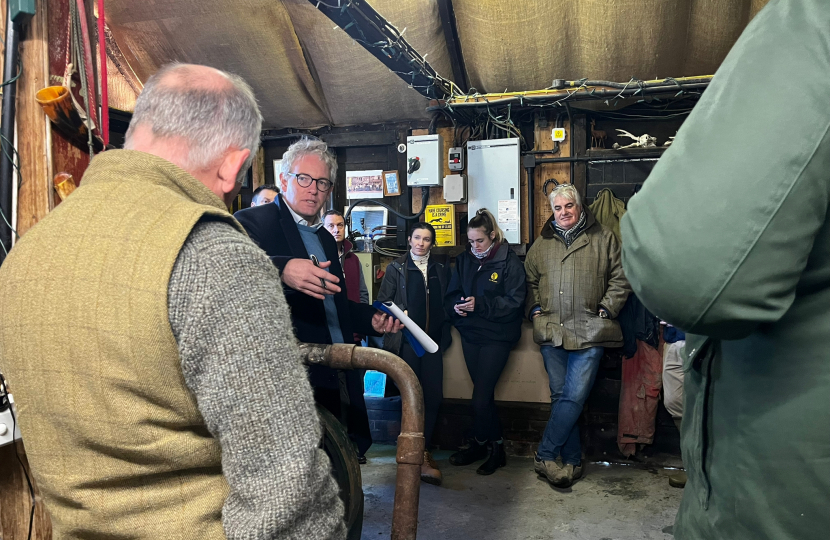
I had a meeting with a group of farmers in Alton Barnes last week, organised by the NFU, discussing the Government’s plans for a transformation of the farm subsidy system. In this post I try to summarise their main points and explain what Government is doing, and where I think further reforms or improvements are needed.
Farming is transitioning from the system that applies across the EU, where farmers are paid simply for owning land, to a system based on subsidies for ‘public goods’. Thankfully, after pressure from me and other MPs, ‘public goods’ includes that most essential function of the land, the production of food. But it also includes many other good things, most of which farmers either do anyway or want to do.
The new system - the Environmental Land Management Schemes (ELMS) - will pay for sustainable farming practices, improving animal health and welfare, reducing carbon emissions, creating and preserving habitat, and making landscape-scale environmental changes. Three ELMS schemes are now live, and the Government is continuing to expand and enhance the Countryside Stewardship (CS) scheme which existed before.
The Government has pledged to maintain overall levels of farm subsidy, to the same amount as farms received under the old system. One difficultly, however, as the farmers explained last week, is the lack of clarity about how these schemes will work. Another is that initial upfront costs to participate - soil sampling, for example, and some capital investments - are not funded. Together these problems are preventing farmers going ‘all in’, as one told me, particularly with the Sustainable Farming Incentive (SFI) scheme.
This is perhaps why SFI uptake has not been huge so far, while farmers are sticking with the scheme they know, namely Countryside Stewardship (CS). The good news is that the Government has updated payment rates for both CS revenue options and capital items to better reflect the latest costs. On average, there will be a 10 per cent increase in revenue rates and CS capital rates, which cover one-off projects such as hedgerow creation, have also been updated.
SFI is also intended to provide help with the costs of participation. The new SFI Management Payment, worth £20 per hectare, will be made for the first 50 hectares of farm in a SFI agreement, to cover administrative costs and to attract smaller businesses, many of whom are tenant farmers who are currently under-represented in the scheme. For a 50-hectare farm, this could represent a potential increase of as much as 50 per cent.
A theme that emerged in the conversation was the injustice of Defra supporting farms to transition to good environmental practice, rather than rewarding those who already look after nature well. It strikes me that the best system would be one that pays more for results - the actual health of your land - than for activities, so that people who have farmed well for decades will be paid more, and (because healthy land attracts higher subsidies) the price of land will reflect the care that has gone into it. I will explore this theme with Ministers.
If the farmers’ principal concern was with Defra and the administration and funding of ELMS, the local council is also increasingly involved, not least through the delivery of Biodiversity Net Gain commitments. I am concerned about the capacity of the council, given its very tight budget and the ever-growing demand for social care and other services, to effectively administer part of the large and complex farm support system. I undertook to meet with Wiltshire council to better understand their current and future responsibilities and the skills and resources they will be able to bring to this.
We discussed the growing business opportunities of renewable energy, but also the extreme difficulty that farmers are experiencing accessing the grid, to feed in to the energy they are producing. The issue is not a technical but a bureaucratic one. I will look into this and work with the NFU and others to lobby for improvements in the system.
These challenges all come on top of the extreme cost pressures farmers are under, particularly with energy and labour. Inflation of agricultural inputs was running at 30% late last year, though falling energy costs will be helping ease the pain fractionally now. And while food inflation for consumers is also at record highs, the stranglehold the supermarkets have over producers mean that these prices are not feeding back into higher returns for farmers.
Last year Defra agreed to make payments in two tranches, at 6 and 12 months, rather than the usual annual payment, in order to assist with farmers’ cashflow. I was asked about this on Friday and having checked with ministers I am assured the same arrangement will apply this year.
I am also glad that CS rates have been increased to reflect inflation. But overall we badly need input costs to fall, labour shortages to ease, and farm gate prices to pick up - not to mention sector-specific problems like avian flu to reduce. I will continue to make the case to Government for better long-term visibility of evolving schemes so that farmers can plan with confidence.





